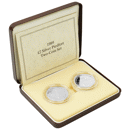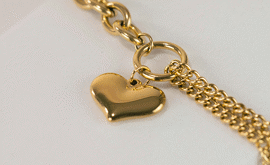What is a Piedfort Coin?
What makes a piedfort coin different?
A piedfort coin stands out from regular coins due to its thickness and weight. Piedfort coins, pronounced ‘pee-ay-fore’, also often spelled ‘piefort,’ are typically twice the thickness and weight of standard coins of the same denomination.
Aesthetically, piedfort coins are typically crafted in a higher quality than regular coins. Like all proof coins, they are struck more than once using a higher level of care and attention than bullion and circulating coins, ensuring sharper detail and a higher-quality finish. Collectors often prize these coins not only for their rarity but also for their superior artistry.
Piedfort coins are usually produced in limited quantities, making them rare and highly sought after by numismatists, and are typically presented in a box with a certificate of authenticity. Their limited mintage also often coincides with special occasions, anniversaries, or commemorative events.
| Coin Type | Metal | Regular Coin Weight | Piedfort Coin Weight |
|---|---|---|---|
| 50p | Silver | 8.00g | 16.00g |
| £1 | Silver | 9.50g | 19.00g |
| £2 | Silver | 12.00g | 24.00g |
| £5 | Silver | 28.28g | 56.56g |
| 50p | Gold | 15.50g | 31.00g |
| Full Sovereign | Gold | 7.98g | 15.96g |
The history of piedfort coins
The first ever piedfort coins were minted in France during the twelfth century. The name ‘piedfort’ is a compound of the French words ‘pied’ meaning ‘foot’, and ‘fort’ meaning ‘heavy’, together meaning ‘heavy foot’ or ‘heavy weight’.
French monarchs traditionally presented visiting dignitaries with these extra thick coins as gifts, showing off the wealth and power of the kingdom. These prestige pieces were also made by noble people and kings to display.
Piedfort coins were also often made as ‘patterns’ (trial pieces), to evaluate a proposed coin design, and distribute them to each of the regional mints in order to be copied. The coins were produced extra thick to distinguish them from regular circulation coins. This practice began in England during the reign of Edward I (1272-1307), with the last English piedfort coin produced for this purpose being a 1588 sixpence coin.
The tradition of minting piedfort coins as prestige pieces eventually faded in the eighteenth century. However, in the 1890s, the Monnaie de Paris once again began producing piedfort coins, this time to cater to collectors. The Royal Mint followed nearly a hundred years later in the 1980s, minting a piedfort version of a UK coin for public availability, which proved to be a success. The Royal Mint has since produced limited numbers of modern piedfort coins to proof quality regularly, usually to celebrate a new coin design or commemorate a special event or anniversary.
Buying and selling piedfort coins
Buying and selling piedfort coins can be rewarding, provided that you ensure you educate yourself on the historical and numismatic significance of the coins, as well as keep updated with the current price of precious metals, in order to understand their value. It is also important to buy your coins from a reputable dealer.
Gold and silver piedfort coins can have many benefits to collectors due to their high-quality striking standards, extremely low mintages, and their double thickness and weight. Due to their precious metal content and rarity, these coins can sometimes appreciate in value over time.
When it comes to selling your piedfort coins, it is essential to choose the right platform to sell your coins, such as a reputable coin dealer, in order to ensure you get a fair price as well as exceptional service. Understanding market trends and current prices will also help you to time your sale correctly.
Piedfort coins blend historical tradition and modern craftsmanship, making them highly sought after by collectors. Their unique thickness and weight, combined with low mintages and high-quality finishes, set them apart from standard coins and ensure they will be enjoyed by collectors for many years to come.
Why Join Our Mailing List?
By signing up, you'll gain access to exclusive updates, early announcements, and tailored insights into the world of bullion and precious metals.

Latest Updates On Bullion

New Releases

Special Offers

Market Analysis
This blog represents one person’s opinion only. Please note, gold and silver prices may go down as well as up. Atkinsons Bullion & Coins accepts no responsibility for any losses based on information we have provided. We do not offer investment advice. Please carry out your own research before making an investment decision.


















